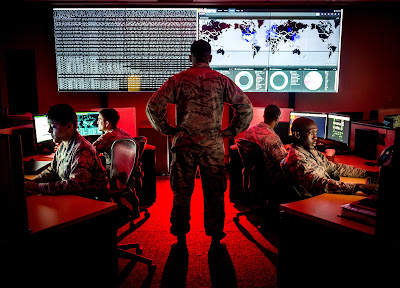Navy Petty Officer 2nd Class
Ignacio D. Perez at the DoD News offers the below piece:
WASHINGTON, Feb. 27, 2018 —
Although competitors such as China and Russia remain the greatest threat to
U.S. security, rogue regimes such as Iran and North Korea have increased in
capabilities and have begun using aggressive methods to conduct malicious cyberspace
activities, the military’s top cyber officer told Congress today.
Navy Adm. Michael S. Rogers (seen in the below photo),
director of the National Security Agency, commander of U.S. Cyber Command and
chief of the Central Security Service, testified at a Senate Armed Services
Committee hearing.
“Our adversaries have grown
more emboldened, conducting increasingly aggressive activities to extend their
influence without fear of significant consequence,” Rogers said. “We must
change our approaches and responses here if we are to change this dynamic.”
But as the cyber domain has
evolved, Rogers told the senators, Cybercom’s three major mission areas endure:
protecting the Department of Defense Information Network; enabling other joint
force commanders by delivering effects in and through cyberspace; and defending
the nation against cyber threats through support to the Department of Homeland
Security and others when directed to do so by the president or secretary of
defense.
Joint Force Headquarters
DODIN, the subordinate headquarters responsible for securing, operating and
defending the Defense Department's complex information technology
infrastructure, has achieved full operational capability, he said.
Joint Task Force Ares,
created to lead the fight in cyber against the Islamic State of Iraq and Syria,
has successfully integrated cyberspace operations into broader military
campaigns, has achieved some “excellent results,” and will continue to pursue
ISIS in support of the nation's objectives, the admiral told the Senate panel.
Cybercom also has
significantly enhanced training in cyber operation platforms to prepare the
battlespace against key adversaries, he said.
Milestones expected to be
achieved this year include Cyber Command’s elevation to a combatant command
responsible for providing mission-ready cyberspace operations forces to other
combatant commanders, Rogers said.
In addition, the admiral
said, Cybercom will be moving into a state-of-the-art integrated cyber center
and joint operations facility at Fort Meade, Maryland, enhancing the
coordination and planning of operations against cyber threats.
“Without cyberspace
superiority in today's battlefield, risk to mission increases across all
domains and endangers our security,” Rogers said.
Cybercom’s focus on
innovation and rapid tech development has extended all the way to small
businesses and working with the private sector while maintaining cybersecurity,
Rogers told the committee.
“We intend in the coming year
to create an unclassified collaboration venue where businesses and academia can
help us tackle tough problems without needing to jump over clearance hurdles,
for example, which for many are very difficult barriers,” Rogers explained.
After serving more than four
years as a commander of Cybercom and after nearly 37 years of service as a
naval officer, Rogers is set to retire this spring.
“I will do all I can during
the intervening period to ensure the mission continues, that our men and women
remain ever motivated, and that we have a smooth transition,” he said.



No comments:
Post a Comment